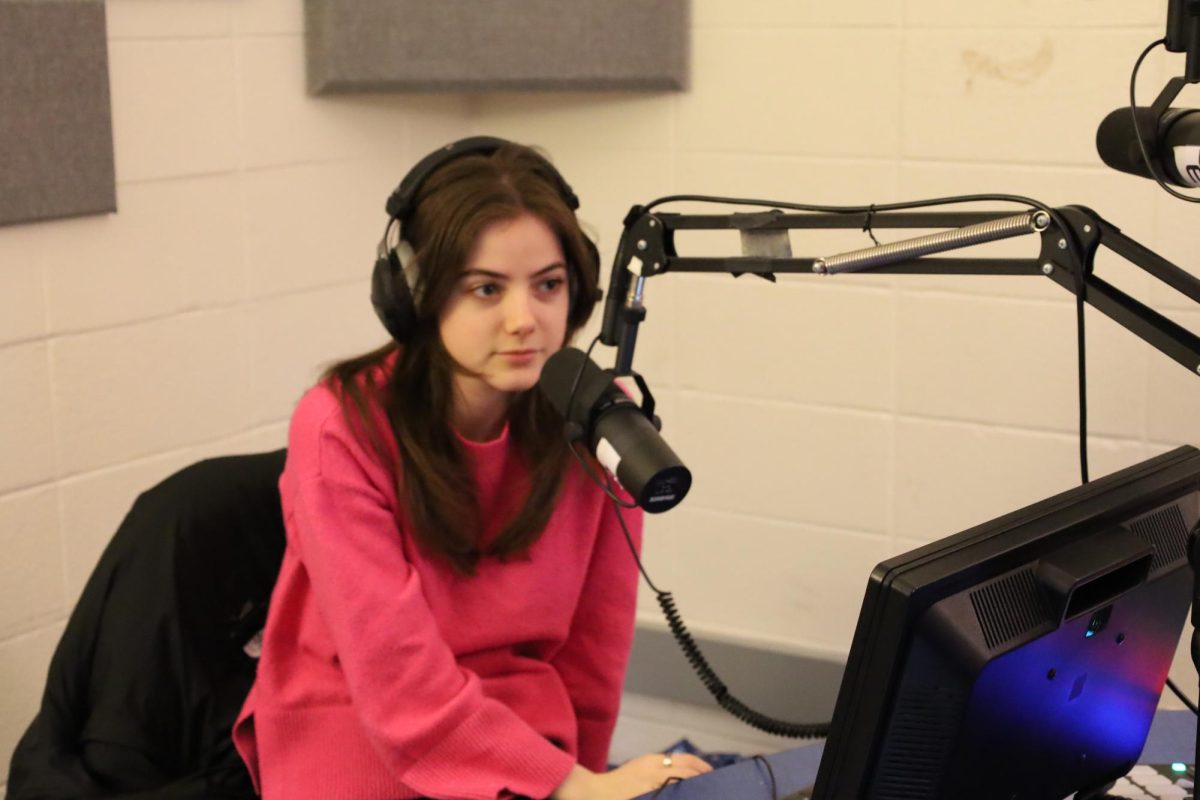This school’s radio system, 91.3 WHJE, has a frequently updated website and relatively popular Instagram, TikTok, Facebook and YouTube platforms – but it hasn’t always been this way. Even though the station itself developed in 1963, Ava Beckman, WHJE website manager and senior, said the social media platforms are newer, and the WHJE website was only developed about 10 years ago.
“The earliest (content) that I’ve seen (on our website) was (from) 2013,” Beckman said, “although it might have been (developed) a little bit before then.”
WHJE adviser Dominic James said the radio station hasn’t just increased its online presence, but the station has also grown a lot bigger within this school as well.
“When I started (in 2017), there were 65 people on staff and two staff classes,” James said. “We now have four staff classes and 106 staff members, so (the program) has grown significantly. All of the staff classes are pretty full… and we cover far more sports and games than we used to do before. We do a lot more live shows (than when I started as an adviser).”
WHJE’s digital adaptation is not unique. All around the country, in high schools and professional newsrooms alike, journalism has been appearing more and more online, as opposed to in print or on paper. Those rising numbers reflect changes in social media usage as well. According to Maryville University, print news has been declining since the rise of digital journalism, but the percentage of social media journalists has skyrocketed.

Similar to WHJE’s evolution, Rebecca Lee, CHTV news anchor and senior, said CHTV has also been expanding its online presence.
“We have a separate social media team. They basically manage the CHTV social media, they’ll post the latest Carmel events. We post sports stuff, we post local Carmel events, and (our platform) is like CHTV, but on Instagram,” Lee said.
For her part, CHTV adviser Brandy Ostojic said CHTV’s many platforms have a good amount of followers. She said CHTV has over 3,000 subscribers on YouTube and Instagram, as well as over 500 on TikTok.
Additionally, Lee said that during her time on CHTV’s staff, she has seen a great deal of improvement in the quality of their SRT television broadcasts due to the evolution of the technology used by the staff.
“I think the newscasts have certainly gotten a lot better,” Lee said. “Our interviews have gotten a lot better, too. Our way of gathering news and stories from the community and the school (has also improved).”
Beckman said she had seen a lot of similar improvement in regards to the amount and quality of WHJE’s broadcasts, and said she credited that improvement to the student leaders.
“I think that our (management) is doing a really good job,” Beckman said. “There’s a lot of very strong leadership, and everybody is very mature in how they handle things, and how they guide other people and lead.”
James said he agreed with Beckman about the strength of the management team, and added that he didn’t exercise much control over what the staff members produced.
“I think one of the reasons why people do well in radio is because I give them a lot of autonomy, and a lot of choice, so they can do the subjects they actually want to do shows about,” James said. “I’m quite happy for people to talk about anything at all, but it’s the way they talk about it (that matters), and that’s what I’m there for.”
Ostojic said she allows similar freedom for her students on CHTV, and that, overall, she is proud of the online content students in CHS produce.
“I just want (people) to think about how all students in the Greyhound Media Network are essentially putting their coursework out there for all to see,” Ostojic said. “It could be the Pinnacle yearbook, a story on HiLite’s website, a radio show on WHJE or a live game on CHTV’s YouTube page. It’s nerve wracking. It takes a special kind of (student) to be able to do that.”

































![AI in films like "The Brutalist" is convenient, but shouldn’t take priority [opinion]](https://hilite.org/wp-content/uploads/2025/02/catherine-cover-1200x471.jpg)









































![Review: “The Immortal Soul Salvage Yard:” A criminally underrated poetry collection [MUSE]](https://hilite.org/wp-content/uploads/2025/03/71cju6TvqmL._AC_UF10001000_QL80_.jpg)
![Review: "Dog Man" is Unapologetically Chaotic [MUSE]](https://hilite.org/wp-content/uploads/2025/03/dogman-1200x700.jpg)
![Review: "Ne Zha 2": The WeChat family reunion I didn’t know I needed [MUSE]](https://hilite.org/wp-content/uploads/2025/03/unnamed-4.png)
![Review in Print: Maripaz Villar brings a delightfully unique style to the world of WEBTOON [MUSE]](https://hilite.org/wp-content/uploads/2023/12/maripazcover-1200x960.jpg)
![Review: “The Sword of Kaigen” is a masterpiece [MUSE]](https://hilite.org/wp-content/uploads/2023/11/Screenshot-2023-11-26-201051.png)
![Review: Gateron Oil Kings, great linear switches, okay price [MUSE]](https://hilite.org/wp-content/uploads/2023/11/Screenshot-2023-11-26-200553.png)
![Review: “A Haunting in Venice” is a significant improvement from other Agatha Christie adaptations [MUSE]](https://hilite.org/wp-content/uploads/2023/11/e7ee2938a6d422669771bce6d8088521.jpg)
![Review: A Thanksgiving story from elementary school, still just as interesting [MUSE]](https://hilite.org/wp-content/uploads/2023/11/Screenshot-2023-11-26-195514-987x1200.png)
![Review: "When I Fly Towards You", cute, uplifting youth drama [MUSE]](https://hilite.org/wp-content/uploads/2023/09/When-I-Fly-Towards-You-Chinese-drama.png)
![Postcards from Muse: Hawaii Travel Diary [MUSE]](https://hilite.org/wp-content/uploads/2023/09/My-project-1-1200x1200.jpg)
![Review: "Ladybug & Cat Noir: The Movie," departure from original show [MUSE]](https://hilite.org/wp-content/uploads/2023/09/Ladybug__Cat_Noir_-_The_Movie_poster.jpg)
![Review in Print: "Hidden Love" is the cute, uplifting drama everyone needs [MUSE]](https://hilite.org/wp-content/uploads/2023/09/hiddenlovecover-e1693597208225-1030x1200.png)
![Review in Print: "Heartstopper" is the heartwarming queer romance we all need [MUSE]](https://hilite.org/wp-content/uploads/2023/08/museheartstoppercover-1200x654.png)



